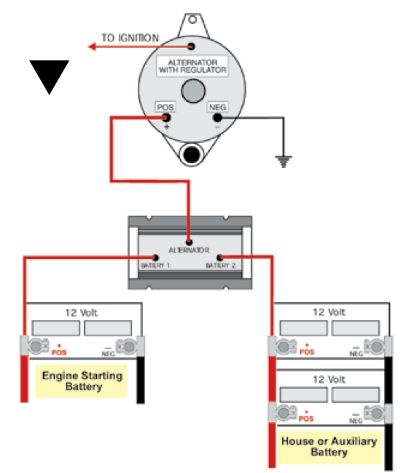

Originally Posted by
haugy

The only difference is the automatic relay that switches batteries for you. Which in my opinion is actually a weakness, not a benefit. (sorry wotan). I've had battery banks and battery switching systems fail before. The ones that had electronic by-passes and relays were always the biggest headache to deal with.
One is straight manual with no digital overrides, the other is designed to take the guess work out of it all. But they are still the same when you step back and look at them.
Those 2 switches are a night an day different from each other in both wiring configuration and use. The existence of the ACR/VSR is only a small part of how the 2 systems very.
A standard 1/2/BOTH/OFF switch has 3 cable studs: BATT-1, BATT-2 and COMMON. in a typical configuration, ALL boat and house loads, with the exception of the auto bilge wire, terminate to the "C" post of the switch. Its a totally manual system with the loads drawing from which ever battery bank the switch is turned to and in turn, the alternator will feed which ever bank the switch is turn to, when the engine is running. It will allow for the user to select which battery to start the engine with and which battery to allow the house loads to draw form when the boat is anchored. And as long as the switch is NOT in the "BOTH" position, you will always have one battery held in reserve for a restart after anchoring.
The Dual-Circuit Plus switch has 4 cable posts: 1A for boat loads, 1B to main battery, 2A for house loads such as stereo, and 2B for the dedicated house battery. It has 2 switch positions as opposed to the 4 that a traditional switch has; OFF, ON and COMBINE. OFF disconnects ALL loads, whether its a house or boat load, from their perspective battery. When in the ON position, 2 contacts close, connecting 1A to 1B and 2A to 2B. So now all loads are connected to their dedicated battery, but the 2 banks are completely isolated from each other. Boat loads will not draw form the house battery and stereo loads will not draw from the main cranking battery, even with the engine off. Only when in COMBINE, are the 2 banks connected. This would be for an emergency start or if the house bank has been drawn down very deep, and the ACR/VSR bouncing closed/opened due to the excessive load of the depleted house bank. The semi-manual Dual-circuit pluss ACR/VSR system is a great setup, buts its not right for every boat system. A large house bank and heavy draw stereo can easily exceed the design capabilities of the ACR/VSR. In that case, a standard manual switch or complete stand-alone house bank would be better.
Although a little unconventional, you could use an ACR/VSR or even a diode type Iso with a traditional 1/2/BOTH switch, but you would not want to use the Dual-Circuit Plus switch without the ACR/VSR as part of the system.
Haugy, of the ACR/VSR was a weakness for you, then your system is one of those that sounds like the ACR/VSR is not the right solution. its not that the ACR/VSR is faulty, just wrong application for a good system. It would be a setup to fail situation. I hope this sheds some light on to these 2 systems.
Michael
Mikes Liquid Audio
